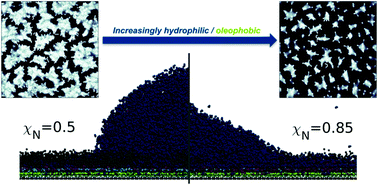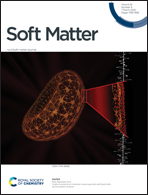Coarse-grained molecular models of the surface of hair†
Abstract
We present a coarse-grained molecular model of the surface of human hair, which consists of a supported lipid monolayer, in the MARTINI framework. Using coarse-grained molecular dynamics (MD) simulations, we identify a lipid grafting distance that yields a monolayer thickness consistent with both atomistic MD simulations and experimental measurements of the hair surface. Coarse-grained models for fully-functionalised, partially damaged, and fully damaged hair surfaces are created by randomly replacing neutral thioesters with anionic sulfonate groups. This mimics the progressive removal of fatty acids from the hair surface by bleaching and leads to chemically heterogeneous surfaces. Using molecular dynamics (MD) simulations, we study the island structures formed by the lipid monolayers at different degrees of damage in vacuum and in the presence of polar (water) and non-polar (n-hexadecane) solvents. We also use MD simulations to compare the wetting behaviour of water and n-hexadecane droplets on the model surfaces through contact angle measurements, which are compared to experiments using virgin and bleached hair. The model surfaces capture the experimentally-observed transition of the hair surface from hydrophobic (and oleophilic) to hydrophilic (and oleophobic) as the level of bleaching damage increases. By selecting surfaces with specific damage ratios, we obtain contact angles from the MD simulations that are in good agreement with experiments for both solvents on virgin and bleached human hairs. To negate the possible effects of microscale curvature and roughness of real hairs on wetting, we also conduct additional experiments using biomimetic surfaces that are co-functionalised with fatty acids and sulfonate groups. In both the MD simulations and experiments, the cosine of the water contact angle increases linearly with the sulfonate group surface coverage with a similar slope. We expect that the proposed systems will be useful for future molecular dynamics simulations of the adsorption and tribological behaviour of hair, as well as other chemically heterogeneous surfaces.



 Please wait while we load your content...
Please wait while we load your content...